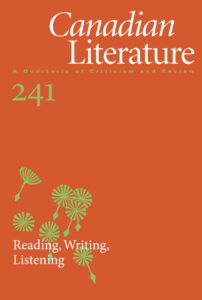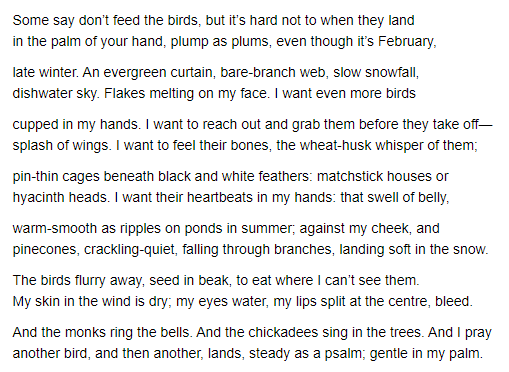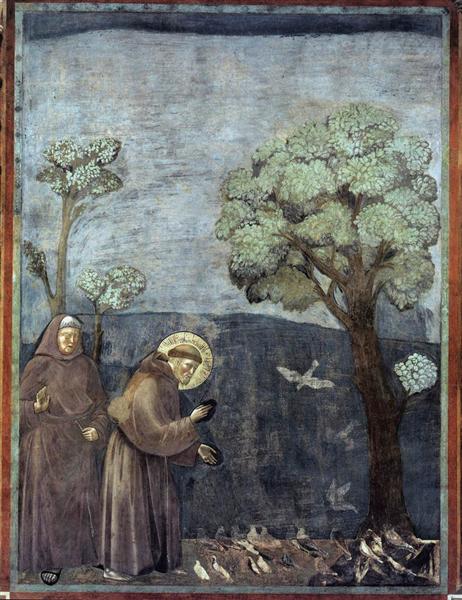This article is the second entry in a series on individual poems. Read the rest of the reviews, essays, or poem-talks here.
“St. Peter’s Abbey, Muenster, Saskatchewan” by Chelsea Coupal

The poem “St. Peter’s Abbey, Muenster, Saskatchewan”, written by Chelsea Coupal, is included in Issue 241: Reading, Writing, Listening of Canadian Literature, published in 2020. I’ve included a screen shot of the poem below, which is also available to read here.

I can quote myself as saying, “who needs another poem about looking at a pigeon?” In other words, who needs another poem that sets out to look and record what is seen? To observe sensorily, and offer a striking, faithful representation of what is heard, tasted, felt — and merely those things? I’ve felt, in various petulant moods, that such poems are nice but unnecessary. At one point, looking directly at an object without ornament was a modernist risk; but today this practice is in surfeit, and largely decorative: another feather on an already gaudy boa. So these poems are unnecessary, but also a low-risk, low-yield form of art. They don’t goad or challenge, of course; but they also don’t add anything to our stuffed banquet of work.
What does seeing do, anyway? Why see or hear or feel through someone else’s eyes and art? Why should art reproduce a pedestrian scene: of someone standing in a courtyard feeding the birds?
Let’s pause these questions; let’s simply read “St. Peter’s Abbey …” and maybe we can revisit this line of thinking and expose why it’s silly.
The first line is one of the more prosaic. It’s brisk; its spoken tone pulls us into the second line where more dramatic sounds and forms begin to appear. But even when the words aren’t showing off, there’s balance: I hear two spondees: “don’t feed” and “hard not,” each anchoring one side of (what could be) a compound sentence. Rhythmically, these make the line feel parallel. Reading ahead, “to when they” feels a bit like a launching pad, a runway to flight: three unstressed syllables, a swift flutter of the tongue, and one that settles, with a stressed thud, on “land.”
When you read, “land/ in the palm of your hand, plump as plums, even though,” the short a (æ) rhyme in “land” and “hand” is heavy, but it’s the alliterative putter of p’s — “palm,” “plump,” “plums” — that gives shape to the sound and heft of the image. You feel it; you flick your tongue against your teeth and blow your cheeks and make a vowel sound that moves from oʊ (“your”) to ʌ (“plump,” “plums”) to oʊ (“though”). At once, I imagine clucking, cooing. The birds are round and ripe as dark fruit and yet “it’s February/ late winter.” They stand more vividly because everything else is dead. I’d quibble that the phrase “late winter” is unnecessary, but it helps extend the line and make the margin even, so in the end I’d keep it — these things make the poem tidy.
“An evergreen curtain, bare-branch web, slow snowfall” — these descriptions seem like set dressing for “dishwater sky,” the more arresting image of the four, which comes smartly at the end of the fragment, at the beginning of a new line. It’s not all pretty. These are all sight-based impressions, so “Flakes melting on my face” pulls us out of one sense and into another — like a cold slap, waking us up, refreshed.
Again, in the next lines, the conversational tone subtly reinforces meaning. “I want even more birds/ cupped in my hands. I want to reach out and grab them before they take off —” Each word of “even more birds” is stressed (trochee + spondee); “I want to reach out and grab them before they take off —” seems to rush ahead and “take off” itself; the em dash, the poet’s favourite punctuation mark (lol), is here used to good effect: the line doesn’t end but alights.
The speaker of this poem, in these lines and onward, is full of insistent desire. The complete phrase “I want” begins these sentences, and the next two. But this is not a typical wistful or dreamy poem, even amid all this wanting. This isn’t about presenting an image and wanting something different, something incongruous or distant or in contradistinction to it; it is about wanting it, here, now, and nothing more than it; it’s about wanting exactly what is experienced, and for that precise, thrilling moment of sensory experience to continue.
There is a real joy in the aptness of the images: the “splash of wings” summons a spray of feather and movement, a kind of wet avian wave; the bones are felt as a most-lovely “wheat-husk whisper,” and as “pin-thin cages” and “match-stick houses,” each directing the hands and fingers to manifestations of fragility, sharpness, brittleness. Piling the images allows the speaker to move from the most immediately ‘felt’ metaphors to more imaginative leaps. The birds’ heartbeats and round bellies take us out of the season — they are “warm-smooth as ripples on ponds in summer” (you can see it!) — and back again into winter, in the full line, “pinecones, crackling-quiet, falling through branches, landing soft in the snow.” This is a tour: through the sonic vividness of “pinecones, crackling-quiet,” and through three commas and a full stop, each punctuation mark slowing us down before arriving, hushed, in white.
But then, we are bereft. “The birds flurry away, seed in beak, to eat where I can’t see them.” We were filled with the delight of looking and touching, in the happiness of what the birds summoned in us, but nothing like this can last; we aren’t Snow White in a grove of woodland beings. In the gospel hymn “His Eye Is on the Sparrow” (1905),* the singer tells us that Jesus watches over every creature, no matter how tiny. Our speaker, here in a Saskatchewan winter, cannot “see” the birds; they retreat in a “flurry” to their own cold orbits. And like any normal person, when a ‘good thing’ is removed — even the smallest, most momentary good thing — they revert to a basic (human) operating mode of suffering: “My skin in the wind is dry; my eyes water, my lips split at the centre, bleed.” We remember again that life is off kilter; we notice again, for the billionth time, that life is a litany of little discomforts.
Hurting, wanting, and yet the world goes on, business as usual, reinforced by the Biblical anaphora of the three “Ands” that begin each of the three final sentences. “And the monks ring the bells. And the chickadees sing in the trees. And I pray …” Now the repeated “I want” we noticed before has turned to an “I pray,” which is a subtle but noticeable shift from the desire of appetite to a desire expressed with meditative depth and humility. One wants a cookie, like the speaker at first wants more birds. We want constantly, in almost every second, and in between seconds. If we are not attentive, we want our lives away. When one prays, on the other hand, one typically isn’t praying for a cookie or a cute bird. But the speaker, plunged into the brief desolation of the dry wind, prays for their return. What do we make of this? Is it simply because the monks are ringing bells and we are (assumedly, from the title) standing before a place of worship? There is a religious mood, a spirit in the air, pushing us to prayer?
In the last line, with “steady as a psalm, gentle in my palm,” the speaker now courts the saccharine. Reading this line aloud, by itself, summons a maudlin, syrupy sweetness. It comes close to killing the poem completely, but I think we’ve so padded the landing with startling imagery that nothing breaks apart on arrival; we settle into its sweetness without it becoming overpowering, becoming fatal. Summoning a “psalm” in the finale also doubles-down on Judeo-Christian imagery that rewires the entire poem as something spiritual — much like a punchline makes a set-up funny in retrospect.
I read “St. Peter’s Abbey …” in dialogue with certain Biblical passages. In Psalm 31:15, the speaker begs to God for assistance, saying “My times are in thy hand: deliver me from the hand of mine enemies, and from them that persecute me.” In Job 12:10, Job reminds Zophar of God’s power, asking, “In whose hand is the soul of every living thing, and the breath of all mankind?” The speaker in “St. Peter’s Abbey …” talks about their hands, their palms, three times: “palm of your hand,” “cupped in your hands,” and “steady in my palm.” Are the birds to the speaker what we are to God, or a God? Are we to transmit the tenderness and surety of the Christian God to the bloody-lipped speaker of this poem, praying that more delicate birds consent to visit? If so, I imagine suddenly a very affectionate God indeed: one who is dazzled by ‘His’ own creation, awed by our human frailty, wishing only we come to ‘Him’ with free will.
I’m reminded as well of Matthew 6:26, in which we are told to “behold the fowls of the air: for they sow not, neither do they reap, nor gather into barns; yet your heavenly Father feedeth them.” We are told to observe, to consider, birds as subjects of divine care and protection, dressed in divine raiment. Perhaps we can do so along with Saint Francis of Assisi, who famously preached to a flock of birds, reminding them their creator loves them dearly, not in spite of their helplessness, but because they are birds. Because they are.
So here we are: “St. Peter’s Abbey …” engages with form and desire. It’s a poem detailing our six senses and corresponding sense objects and corresponding consciousnesses arising from this interplay. It seems to lack any other purpose than to show us a series of moments, as perceived by the speaker, and the impulses these sense impressions arouse. It does so through some considerable technical skill. So, do we ask for more? Is there a need for more?
To speak honestly, and to risk spoiling this talk with sentimentality: every moment of consciousness, poised in the present, and only felt as such by its receding into a then-uncapturable, un-returnable past, is filled, occupied, bursting, with sensory information — data of utter newness, completeness, originality, and often unspeakable beauty. To have a mind is to perceive all of this from one preposterously small side of infinite sides and illimitable ambiguity; to have a mind is to orchestrate this ambiguity into form and then have the capacity to recognize the form’s simultaneous unfixed nature, its root in nothingness, endlessly empty space between atoms.
Looking at something closely, then working to show it from that side, allowing the mind to work, to create metaphor, to then unpack the miraculous experience for others: this is no small challenge. Most people see, hear, smell, taste, feel, and think grief. The miracle, for such minds, inured to seeing clearly, is reduced (abused? defiled?) to utility, to getting pleasure and avoiding pain, to getting something out of it; it ceases to be about anything else other than how it can help win gain, fame, praise, sensation, and so forth. In this mode of being, life is about wanting other things, in the past or future, and little else; it is about wanting exactly what is not experienced, or for those precise, thrilling moments of sensory experience to end, or transform.
Living like this, we don’t see the birds. They never land near us. They never eat from our palms, nor impress us with their softness, warm-smooth as ripples on ponds in summer.
We can still ask for more in poetry. But in poetry, and more importantly, in life, we need to also see the birds.
* For a haunting dialogue with this concept, or its fictitiousness, read Joan Didion’s The Year of Magical Thinking.

1 comment